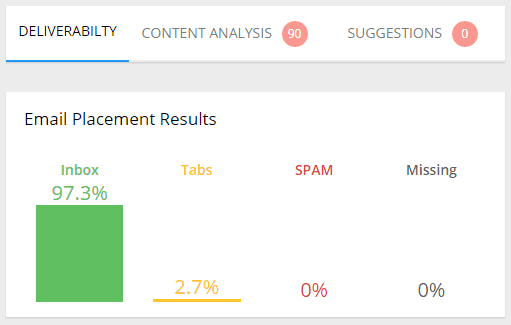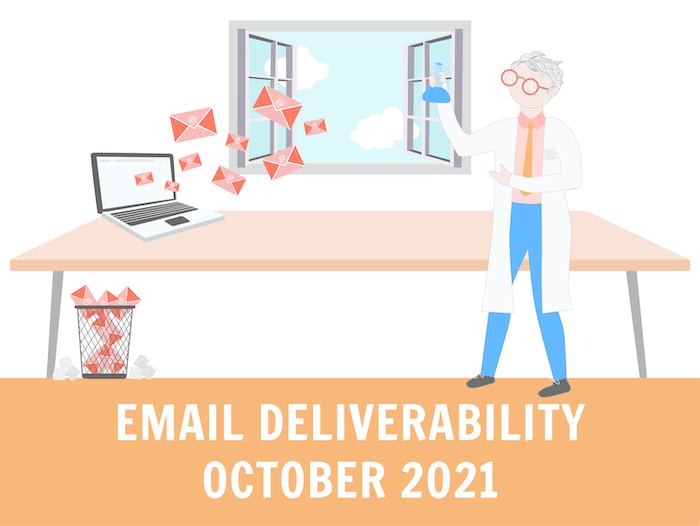EmailTooltester is supported by readers like yourself. We may earn a commission when you purchase through our links. Of course, this won't increase the cost for you.
Update: Please find our latest deliverability test results from Jan 2024 here.
Six months have passed since our last deliverability test, and I have to say that a lot has changed in such a short period of time. And even more has changed since our first tests four years ago!
This is our eighth email deliverability test to date, and you’ll see that there were quite a few movements in the charts.
If you’d like to make a comparison between this test and the previous one, check out our results from March 2021.
For those of you who are coming across our deliverability tests for the first time, this is something we started doing back in August 2017 in order to monitor the deliverability rates of the world’s most popular email marketing services. After all, deliverability is such an important benchmark for this kind of service, and not all newsletter tools are made equal (as you’ll soon find out).
The number of providers we look at has increased slightly since then; this round we included a total of 15 different email services.
How do we test email deliverability?
Five separate tests are carried out over the course of five weeks, using the email deliverability checker Glockapps. You can read more about our methodology here, and also see how the tools have performed over the years.
What is The Definition of Email Deliverability?
To avoid any confusion, let’s take a look at what email deliverability means before we analyze the results.
Email delivery is when an email is successfully delivered to the receiving server (how to calculate email delivery rate).
Email deliverability is when an email successfully arrives in the person’s inbox.
Just because your email was delivered, does not mean that it made it to the right place: the reader’s main inbox. There are, in fact, a number of places your email can end up:
- the spam/junk folder;
- in the case of Gmail, the Promotions tab;
- or, worst of all, it goes missing (undelivered)
The term ‘email deliverability’ covers all the above scenarios, and that’s what we’ve been testing.
If an email ends up in the spam/junk folder or goes missing, it is classed as ‘undelivered’.

So, without further delay, let’s dive into the results of our latest email deliverability test!

Email Deliverability Rankings: Takeaways
- Mailerlite, a previous deliverability champ, holds on to its title with 96%! This is the third time MailerLite has come in first place
- ConvertKit, a winner from a previous round, came in with 94% this time, 2% less than last round
- CleverReach has done consistently well in our last 3 rounds, averaging a score of 93%
- Brevo and Mailjet, providers who have done very well in previous rounds, have taken quite a dip, scoring just 85% and 78% respectively
- ActiveCampaign, who saw a real drop in deliverability this time last year, is steadily climbing back up with 92%
- HubSpot, a new addition last round, went from a very strong 92% to 67%, landing them second to last place.
- After a short-lived improvement, Benchmark has dropped back down to 50%
- Overall, the average deliverability has gone down slightly (85.3%), 3.6% percentage points lower than in March 2021
Where did the emails end up?
The table below shows the averages for where emails ended up for each provider: the main inbox, another tab, the spam folder, or if they went missing.
| TOOL | MAIN INBOX % | TABS % | SPAM % | MISSING % |
|---|---|---|---|---|
| MailerLite | 76.1 | 19.6 | 2.3 | 2 |
| ConvertKit | 79.3 | 14.3 | 2.3 | 4.1 |
| CleverReach | 75.2 | 18.1 | 5.0 | 1.7 |
| ActiveCampaign | 77.0 | 14.6 | 2.9 | 5.5 |
| Constant Contact | 74.8 | 12.9 | 4.9 | 7.4 |
| Moosend | 79.5 | 8.6 | 8.7 | 3.2 |
| MailChimp | 69.7 | 15.4 | 11.9 | 2.9 |
| Brevo | 76.4 | 8.1 | 11.6 | 3.8 |
| Omnisend | 75.2 | 10.1 | 6.4 | 8.3 |
| Drip | 70.9 | 10.5 | 5.3 | 13.4 |
| Mailjet | 61.0 | 16.8 | 12.0 | 10.2 |
| GetResponse | 52.2 | 23.9 | 18.4 | 5.5 |
| AWeber | 54.3 | 17.8 | 20.4 | 7.5 |
| HubSpot | 44.9 | 22.2 | 25.9 | 7.0 |
| Benchmark | 30.0 | 19.6 | 29.5 | 20.9 |
- The providers least likely to have emails end up in the spam folder were MailerLite (2.3%), ConvertKit (2.3%) and ActiveCampaign (2.9%)
- The providers most likely to be flagged as spam were Benchmark (29.5%), HubSpot (26%) and AWeber (20.4%)
- The providers least likely to have emails go missing were CleverReach (1.7%), MailerLite (2%) and Mailchimp (2.9%)
- The providers most likely to have emails go missing were Benchmark (20.9%), Drip (13.4%) and Mailjet (10.2%).
Deliverability to Most Popular Mailbox Providers
There are heaps of mailbox providers out there, and while our tests were sent to over 30 different ISPs internationally, we couldn’t record them all. Instead, they were weighted according to importance. The following table summarizes the average deliverability rates to Gmail, Yahoo, Microsoft (Hotmail + Outlook) and AOL. For Gmail, we’ve differentiated between the emails that arrived in the main inbox and the Promotions tab.
| TOOL | GMAIL INBOX % | GMAIL PROMOTIONS % | YAHOO % | AOL % | MICROSOFT % |
|---|---|---|---|---|---|
| MailerLite | 15% | 81.54% | 100% | 100% | 95.7% |
| ConvertKit | 42% | 58.46% | 100% | 100% | 95.7% |
| CleverReach | 22% | 78.46% | 100% | 89% | 95.7% |
| ActiveCampaign | 40% | 60.00% | 89% | 100% | 94.3% |
| Constant Contact | 40% | 60.00% | 100% | 100% | 94.3% |
| Moosend | 60% | 40.00% | 100% | 97% | 94.2% |
| MailChimp | 40% | 60.00% | 89% | 100% | 74.3% |
| Brevo | 75% | 20.00% | 78% | 80% | 95.7% |
| Omnisend | 60% | 40.00% | 100% | 100% | 92.9% |
| Drip | 49% | 41.54% | 100% | 71% | 95.7% |
| MailJet | 35% | 61.54% | 36% | 94% | 76.2% |
| GetResponse | 0% | 100.00% | 100% | 100% | 15.7% |
| AWeber | 18% | 73.85% | 89% | 100% | 7.1% |
| HubSpot | 0% | 100.00% | 100% | 100% | 16.1% |
| Benchmark | 0.17% | 83.08% | 0% | 0% | 0.0% |
- The providers most likely to end up in Gmail’s main inbox were Brevo (75%), Moosend (60%) and Omnisend (60%)
- The providers most likely to end up in Gmail’s Promotions tab were GetResponse (100%), HubSpot (100%) and Benchmark (83%)
- MailerLite, Brevo, ConvertKit, Drip and CleverReach landed 96% of emails in Outlook and Hotmail inboxes
- Benchmark didn't manage to deliver any emails to Yahoo, Hotmail, Outlook and AOL inboxes
- Drip (9%), AWeber (8%), Brevo (5%), Mailjet (3%) and MailerLite (3%) saw a portion of their emails either go missing or end up in the Gmail spam folder.
Overall ratings based on historical performance
We’ve seen that deliverability rates tend to fluctuate over time. Just because a tool hasn’t performed quite so well this round, doesn’t mean it doesn't have a good deliverability track record. We’ve assigned a star rating to each provider based on its overall performance over the last 3 rounds of testing. You can also see whether it has performed better or worse compared to the last round.
| TOOL | STAR RATING | CHANGE SINCE LAST ROUND |
|---|---|---|
| ConvertKit | ↑ | |
| MailerLite | ↑ | |
| CleverReach | ↑ | |
| Constant Contact | ↓ | |
| Moosend | ↑ | |
| MailChimp | ↑ | |
| Mailjet | ↓ | |
| SendinBlue | ↓ | |
| ActiveCampaign | ↑ | |
| Omnisend | ↓ | |
| Drip | → | |
| GetResponse | ↑ | |
| Hubspot | ↓ | |
| AWeber | ↓ | |
| Benchmark | → |
With 96%, MailerLite takes the number one spot and our ‘Best deliverability’ award.

With 91.2%, MailerLite also wins our ‘Best of 5’ award for best deliverability over the last five rounds of testing.

How does this affect my email marketing strategy?
When you’re choosing a provider, make sure that it has good delivery rates – we’d recommend referring to our historical data to see the upward or downward trends of each tool. You can also do your own tests with Glockapps – here is a sample report.
Email Deliverability Test: Conclusion
Like every round, this email deliverability test has shown that it’s a good idea to monitor this benchmark carefully and take stock of your own tool’s capabilities.
With the average deliverability for all tools decreasing slightly, we’re interested to see if the providers can bring it back up before our next round, six months from now.
That said, according to our tests, MailerLite is clearly the strongest email marketing service when it comes to deliverability right now, landing first place and our best of 5 award.
Other consistent providers are ActiveCampaign and CleverReach.
If you’re looking to change services or are just starting out with email marketing, we hope this can serve as a guide when deciding on which provider to go with. However, I recommend that you use it as a reference alongside your own research and make sure to carry out your own tests. You can make the most of free plans and trial periods to run these.
If you’re using a tool that’s at the bottom of the table and whose performance is declining (GetResponse and AWeber) it might be time to reconsider. I’d advise you to take a look at your reports and conduct a few tests of your own using Glockapps or another service.
We run these tests bi-annually, so keep an eye out for the results of our next round early 2022.
Noticed any deliverability issues with your email marketing service? Or have any questions about our tests? Let us know in the comments below!
Our Methodology
This article has been written and researched following our EmailTooltester methodology.
Our Methodology

